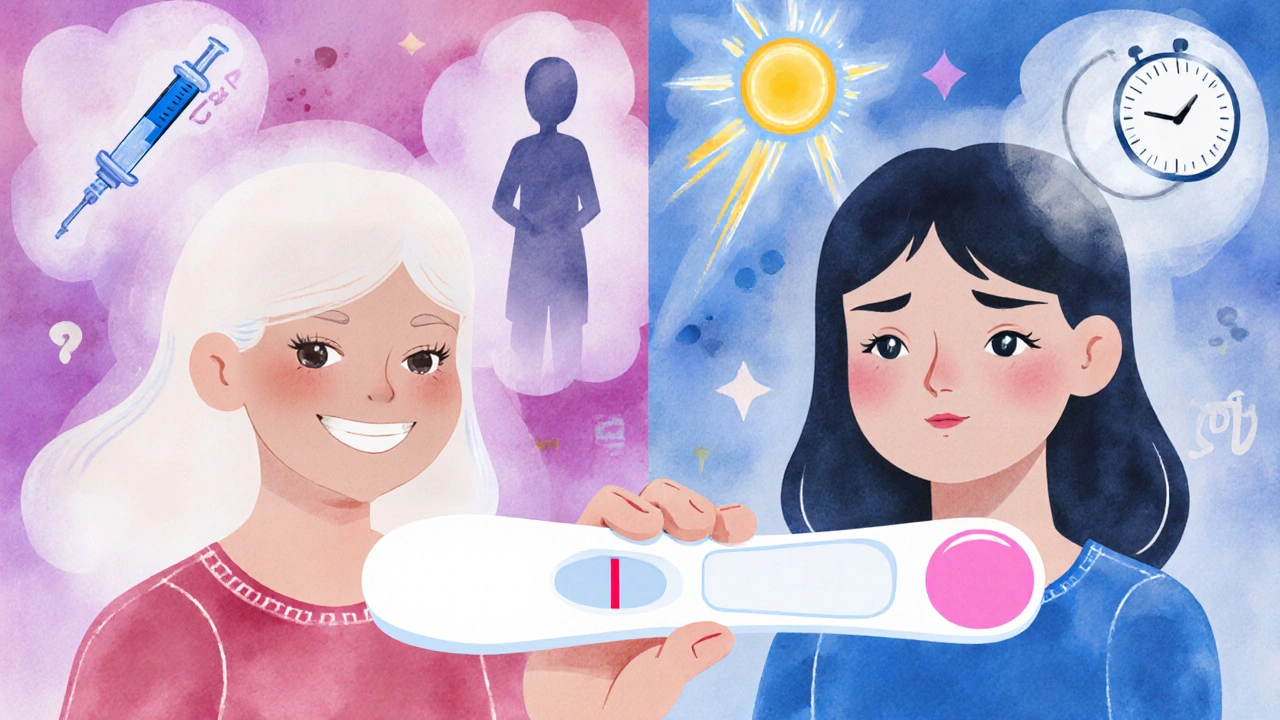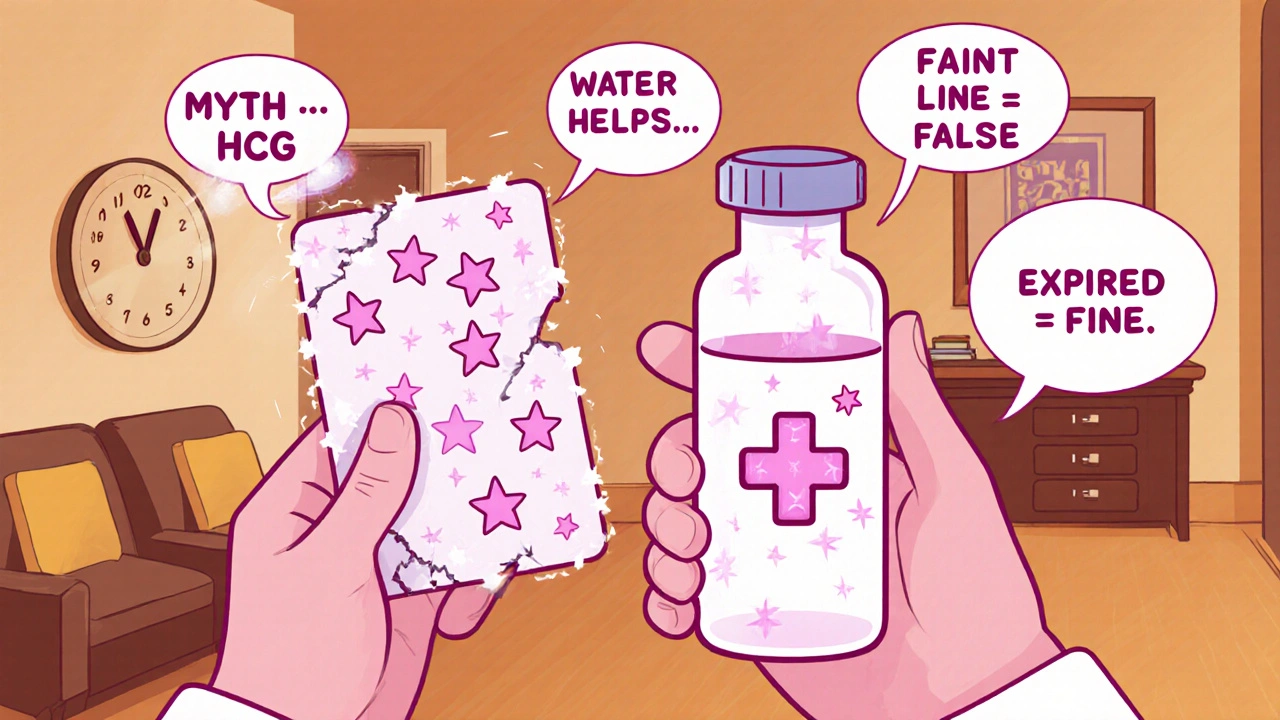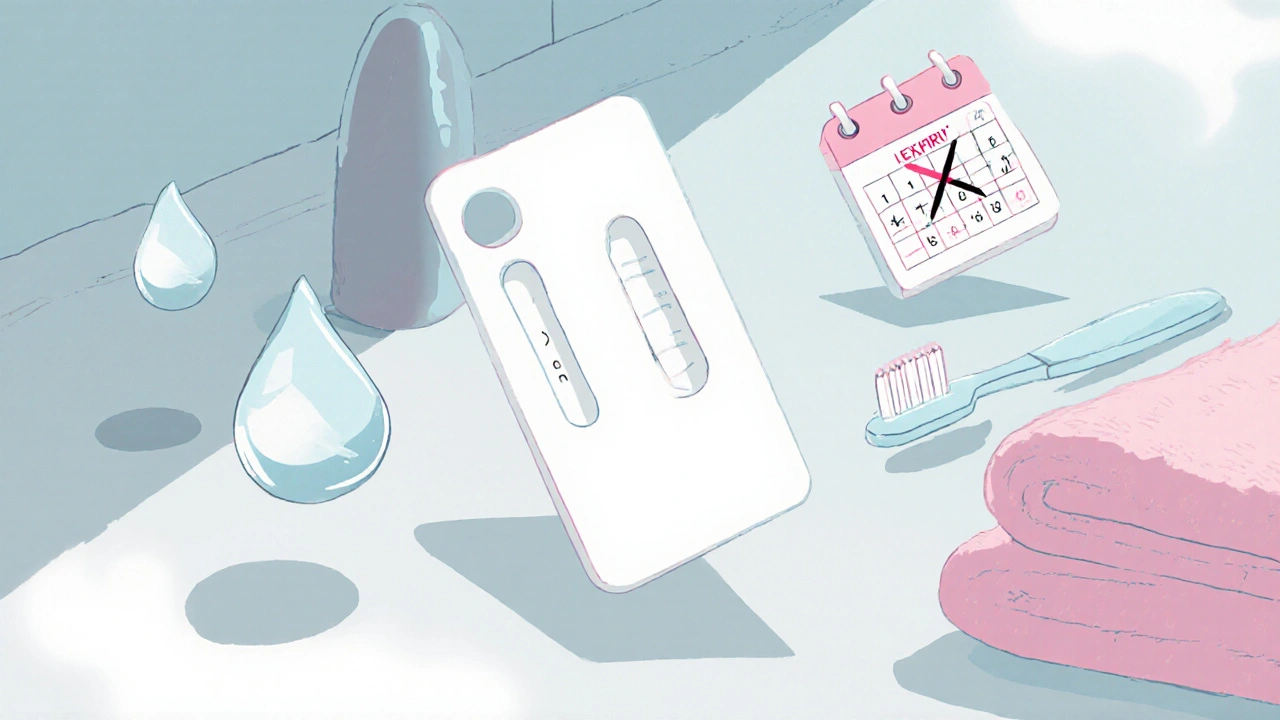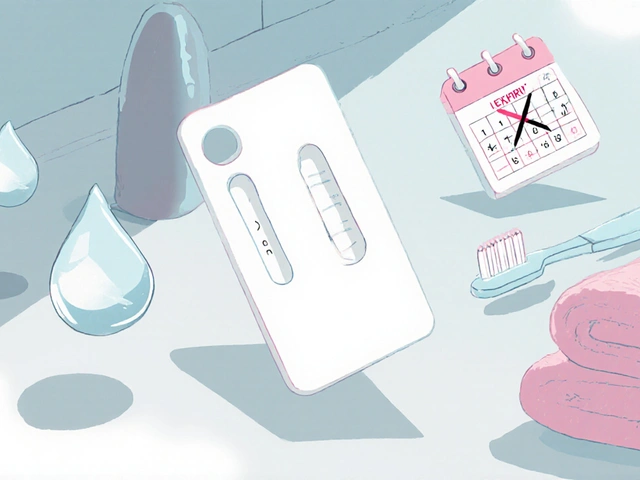You bought a pregnancy test card. You waited the few minutes. One line. Two lines. Your heart skips. Then you start doubting: Could this be wrong? You’re not alone. Thousands of people second-guess their results every month. And for good reason-there’s so much noise out there. Myths about evaporation lines, expired tests, and drinking too much water before testing are everywhere. But here’s the truth: pregnancy test cards are accurate most of the time. Still, they can give false results-and knowing why matters more than ever.
How pregnancy test cards actually work
Pregnancy test cards detect one hormone: hCG. That’s human chorionic gonadotropin. It’s made by the placenta after a fertilized egg attaches to the uterus. Most test cards can spot hCG as low as 20 mIU/mL. That’s usually around the time your period is due. Some ultra-sensitive ones go as low as 10 mIU/mL, which means they can pick up pregnancy a few days earlier.
Inside the test card is a strip coated with antibodies that stick to hCG. When your urine flows over it, those antibodies grab any hCG present. Then a chemical reaction shows up as a colored line. One line? Negative. Two lines? Positive. Simple. But simplicity doesn’t mean perfection.
False negatives: When the test says no, but you’re pregnant
False negatives happen more often than false positives. And they’re usually due to timing. If you test too early, your hCG levels might be too low for the test to catch. A 2023 study in the Journal of Obstetrics and Gynecology found that 1 in 5 women who tested negative on the first day of a missed period were actually pregnant-when tested again a week later.
Other reasons:
- You drank a lot of water before testing. Diluted urine = lower hCG concentration.
- You didn’t follow the instructions. Waiting too long to read the result? That’s a common mistake.
- The test is old or damaged. Exposure to heat, moisture, or direct sunlight can ruin the chemicals inside.
- You have a very early miscarriage-sometimes called a chemical pregnancy. hCG rises briefly, then drops fast. The test might catch it, then turn negative soon after.
Bottom line: If your period doesn’t come and the test says negative, wait 3-5 days and test again. Use first-morning urine. It’s the most concentrated.
False positives: When the test says yes, but you’re not pregnant
False positives are rare-under 1% of cases-but they do happen. And they’re scary. You might see two lines and assume you’re pregnant, only to find out later you’re not.
Here’s what can cause it:
- You recently had a miscarriage or abortion. hCG can linger in your system for weeks.
- You’re taking fertility drugs that contain hCG. Some injections, like Ovidrel or Pregnyl, are designed to trigger ovulation-and they can mess with test results for up to 10 days after use.
- You have a medical condition. Rare tumors, like gestational trophoblastic disease or certain ovarian cancers, can produce hCG.
- You have a faulty test. Manufacturing errors happen. A test might have a defective strip or contamination.
Evaporation lines are often blamed. But they’re not true positives. They’re faint, colorless streaks that appear after the recommended reading time (usually 10 minutes). If you see a line after 15 minutes, it doesn’t count. Always read the result within the time window on the box.

Expired or improperly stored tests: The silent saboteurs
Most people don’t check the expiration date. Or they store the test in the bathroom-right next to the shower. Humidity and heat break down the antibodies inside the test card. A 2024 lab test by Consumer Reports found that tests stored at 90°F (32°C) for 6 months lost up to 40% of their sensitivity.
Always store pregnancy tests in a cool, dry place. A drawer, not a medicine cabinet. Check the date. If it’s expired, throw it out. Don’t risk it.
Medications and medical conditions that interfere
Most common meds-birth control pills, antibiotics, painkillers-don’t affect pregnancy tests. But some do.
- HCG injections for fertility treatments: These are the biggest culprits. If you’re undergoing IVF or ovulation induction, your doctor should tell you when it’s safe to test.
- Pituitary disorders: Rare conditions like hypergonadotropic hypogonadism can cause elevated hCG without pregnancy.
- Menopause: In rare cases, postmenopausal women produce trace amounts of hCG. This can cause false positives in older women who aren’t aware of this possibility.
If you’re on any hormone therapy or have a history of cancer, talk to your doctor before trusting a home test. Blood tests are more accurate and can distinguish between different types of hCG.
When to trust the test-and when to see a doctor
Here’s a simple rule: If you get a positive result, believe it. Even if you feel nothing, even if you’re not sure. A true positive is almost always real.
But if you get a negative result and your period still hasn’t come after a week, test again. Or better yet, go to a clinic. A blood test can measure exact hCG levels and confirm pregnancy with 99% accuracy. It can also catch early problems-like ectopic pregnancy or low hCG progression-that a home test can’t.
Don’t wait for symptoms. Some women have no morning sickness, no breast tenderness, no fatigue-and still have a healthy pregnancy. Others feel everything and aren’t pregnant. Symptoms aren’t reliable. Only hCG is.

What to do if you’re confused by your results
Follow this checklist:
- Check the expiration date.
- Use first-morning urine.
- Wait the full time (usually 3-5 minutes) before reading.
- Don’t read results after 10 minutes.
- Use a new test if you’re unsure.
- If still confused, get a blood test.
Keep in mind: No home test is 100% perfect. But when used correctly, pregnancy test cards are more than 99% accurate from the day your period is due.
Myth vs. Fact: Quick debunking
- Myth: Drinking lots of water makes the test more accurate.
Fact: It dilutes hCG. That’s why you get false negatives. - Myth: A faint line means it’s not real.
Fact: Any second line, even faint, is a positive. It just means hCG is low. - Myth: Only expensive tests work.
Fact: Generic brands are just as accurate if they’re not expired and stored properly. - Myth: You can’t get pregnant right after your period.
Fact: Ovulation timing varies. Sperm can live for 5 days. Testing too early is the real issue.
The bottom line? Pregnancy test cards are reliable tools-but they’re not magic. They need to be used right. And they’re not a substitute for medical confirmation when something feels off.
Can a pregnancy test card be wrong if I test too early?
Yes. Testing before your missed period increases the chance of a false negative because hCG levels may still be too low. Most tests are designed to be accurate from the first day of a missed period. For the most reliable result, wait until then or use a test labeled as "early detection" and confirm with a blood test if unsure.
Can a UTI cause a false positive pregnancy test?
No. Urinary tract infections (UTIs) do not produce hCG, so they won’t cause a false positive. However, severe UTIs with high protein or blood in urine can sometimes cause a faint, misleading line due to chemical interference. This is rare. If you have symptoms of a UTI and a positive test, get both conditions checked by a doctor.
Do fertility treatments affect home pregnancy test results?
Yes. If you’ve had an hCG trigger shot (like Ovidrel or Pregnyl), the hormone can stay in your system for up to 10 days and cause a false positive. Always wait at least 10-14 days after the shot before testing. Your clinic will usually tell you when to test. If you test too soon, you might see a line that fades after a few days-this is called a chemical pregnancy, not a true pregnancy.
Can stress or anxiety affect pregnancy test accuracy?
No. Stress doesn’t change your hCG levels. But it can make you misread results or test too early because you’re anxious. Always follow the instructions, use first-morning urine, and wait the full time before reading. If you’re overwhelmed, ask someone else to read the test for you.
Are digital pregnancy tests more accurate than card tests?
They’re not more accurate-they just display results differently. Digital tests show "pregnant" or "not pregnant" instead of lines. But they use the same hCG detection technology. Both types have the same sensitivity range. Digital tests cost more, but they reduce user error in reading faint lines. If you’re unsure about interpreting lines, a digital test might give you peace of mind.
What should I do if I get conflicting results from two different tests?
If one test is positive and another is negative, wait 48 hours and test again with a new card. Use first-morning urine and the same brand if possible. If results still conflict, visit a clinic for a blood test. Blood tests measure exact hCG levels and can tell if levels are rising as expected in a healthy pregnancy.
Next steps if you’re unsure
If you’ve tested multiple times and still don’t know where you stand, don’t guess. Don’t wait for symptoms. Don’t rely on online forums. Call your doctor or visit a clinic. A simple blood test costs less than $50 in most places and gives you a number-your exact hCG level. That number tells you more than any line on a plastic card.
And if you’re pregnant? Early prenatal care improves outcomes. If you’re not? You can rule out other causes for your symptoms-like hormonal imbalances, thyroid issues, or stress-related changes.
Pregnancy test cards are tools. Not crystal balls. Use them wisely. And when in doubt, let a professional confirm it.





October 30, 2025 AT 22:49 PM
Look i get it you wanna feel smart about your pee stick but lets be real here its just chemistry not cosmic truth
One line two lines who cares if your body says no and you still feel pregnant maybe its your soul not your hCG
Also why are we all so obsessed with lab results when life is just a vibe man
October 31, 2025 AT 05:41 AM
Thank you for this thoughtful and well-researched breakdown. It’s refreshing to see such clarity on a topic often clouded by misinformation. I especially appreciate the emphasis on blood tests as the gold standard - a reminder that medical guidance should always follow, not precede, self-diagnosis.
November 1, 2025 AT 17:11 PM
Stop letting corporations sell you fear. If you’re getting false negatives, you’re testing wrong - not because the test is broken but because you’re too anxious to follow the damn instructions.
First-morning urine. Read the timer. Don’t stare at it for 20 minutes like it’s a Ouija board. Simple. Not rocket science.
November 1, 2025 AT 20:33 PM
OMG YES I WAS SO CONFUSED WHEN I GOT A FAINT LINE AND THOUGHT IT WAS A FAKE
Turned out i was preggo but my urine was kinda watery that day
Now i always use the first pee of the morning and wait exactly 5 mins - no peeking!!
Also bought a digital one after that trauma 😅
November 2, 2025 AT 06:13 AM
Let me break this down for you because nobody else will
Every single pregnancy test is controlled by Big Pharma who also owns the labs that do blood tests
They want you to doubt your home test so you go back for more $$$ confirmations
And don’t get me started on the hCG trigger shot - that’s not medicine that’s a surveillance tool
They’re tracking your hormone levels to predict your fertility window so they can sell you IVF packages
The government knows this too - that’s why they don’t regulate the expiration dates
And why do you think they push ‘early detection’ tests? So you panic earlier and spend more
It’s all a loop - test, doubt, retest, panic, clinic, bill, repeat
Wake up. Your body knows before the strip does.
November 3, 2025 AT 01:22 AM
It’s wild how something so biological - a tiny molecule whispering ‘you’re growing a human’ - gets turned into a plastic rectangle with a deadline.
Like, imagine if your heartbeat had a 10-minute window to be read correctly.
We treat our bodies like broken appliances you have to troubleshoot with a manual.
And yet, we trust these things more than our own instincts.
Maybe the real test isn’t the strip - it’s whether we’re willing to sit with uncertainty.
November 3, 2025 AT 07:06 AM
i just want to say i got a positive then negitive then positive again and i was so confused
turns out i had a chemical pregnancy and i didnt even know it was a thing
now i know to wait a few days and retest
thanks for the info!!
November 4, 2025 AT 16:07 PM
Let’s be intellectually honest here - the entire premise of home pregnancy testing is a statistical illusion predicated on an oversimplified biomarker paradigm.
hCG is not a binary on/off switch - it’s a dynamic, temporally heterogeneous glycoprotein secreted by syncytiotrophoblastic tissue in response to embryonic implantation - and its concentration is subject to diurnal variation, renal clearance rates, and inter-individual metabolic variance.
Furthermore, the immunoassay sensitivity thresholds employed in consumer-grade devices are not calibrated to account for isoform heterogeneity or antibody cross-reactivity with luteinizing hormone - which, coincidentally, peaks during ovulation.
So yes - false negatives are not anomalies - they are systemic artifacts of reductive diagnostic architecture.
And you call that science? It’s a parlor trick with a plastic casing.
November 5, 2025 AT 18:16 PM
so i tested positive then my bf said it looked like a ghost line so i cried for 3 days
then i tested again and it was negative and i felt so betrayed by my own body
then i got my period and i was like wow i thought i was gonna be a mom
but now i just feel empty like i lost something that never existed
is that normal??
anyone else feel like this??
November 7, 2025 AT 00:01 AM
Hey everyone - I just want to say how important it is that we approach this topic with kindness.
Whether you’re hoping for a positive, dreading it, or just confused - your feelings matter more than any line on a stick.
I’ve seen friends go through this - the anxiety, the hope, the heartbreak - and what they needed wasn’t a perfect test.
It was someone to sit with them while they waited.
So if you’re reading this and you’re unsure - breathe.
Get the blood test if you can.
Reach out.
You’re not alone in this.
And no matter the result - your worth isn’t tied to a hormone level.
Love you all.
November 8, 2025 AT 03:29 AM
This article is a textbook example of misleading populism disguised as medical advice.
The assertion that home tests are '99% accurate' is a gross misrepresentation of clinical validation standards.
Accuracy is contingent upon pre-analytical variables - sample collection, storage, timing - none of which are standardized in domestic environments.
Furthermore, the dismissal of evaporation lines as non-significant is scientifically irresponsible.
One must question the integrity of manufacturers who exploit emotional vulnerability for profit.
Regulatory oversight is abysmal.
Recommendation: Abstain from self-diagnosis entirely.
Consult a licensed professional - or remain ignorant. The latter is statistically safer.
November 8, 2025 AT 12:50 PM
I appreciate the effort put into explaining this clearly. It’s easy to feel overwhelmed when you’re trying to understand your body, especially if you’ve been trying to conceive.
Thank you for not adding more fear - just facts.
And for reminding us that it’s okay to wait, to test again, to ask for help.
That’s the kind of information that actually heals.
November 9, 2025 AT 11:13 AM
just had my 3rd test today and got a super faint line again 😭
but this time i smiled and took a pic for my partner - we’re gonna go get a blood test next week
either way we’re proud of ourselves for not panicking
hcg is just a number - we’re already parents in our hearts 💕
November 10, 2025 AT 21:32 PM
Real talk: if you're testing before your missed period, you're playing roulette with your emotions.
Most people don't realize hCG doubles every 48-72 hours in early pregnancy - so testing too early is like trying to measure a snowflake with a ruler.
Use first-morning urine - it's not a myth, it's science.
And if you're on fertility meds? Wait at least 10 days after your trigger shot.
Also - store your tests like you store your coffee. Not in the bathroom. A drawer. Dry. Cool.
Simple stuff. But most people skip it because they're too anxious to read the box.
November 12, 2025 AT 14:58 PM
Bro I tested negative on Monday, then positive on Wednesday - and I didn’t even change my routine.
Turns out I was just *that* close to the threshold.
Now I know why they say ‘wait a week’ - it’s not to make you suffer, it’s because your body needs time to crank up the hCG.
Also - I used a $3 test from the dollar store and it worked fine.
Don’t fall for the ‘premium’ branding. It’s the same damn chemistry.
Stay chill. Stay patient. Your body’s got this.